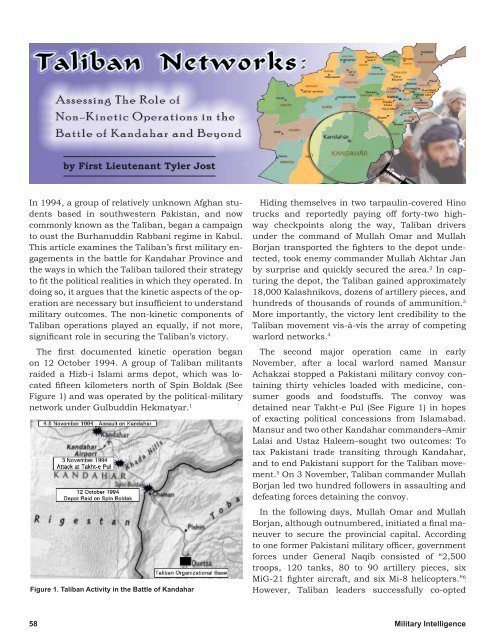George w. casey jr. - Federation of American Scientists
George w. casey jr. - Federation of American Scientists
George w. casey jr. - Federation of American Scientists
You also want an ePaper? Increase the reach of your titles
YUMPU automatically turns print PDFs into web optimized ePapers that Google loves.
y First Lieutenant Tyler Jost<br />
In 1994, a group <strong>of</strong> relatively unknown Afghan students<br />
based in southwestern Pakistan, and now<br />
commonly known as the Taliban, began a campaign<br />
to oust the Burhanuddin Rabbani regime in Kabul.<br />
This article examines the Taliban’s first military engagements<br />
in the battle for Kandahar Province and<br />
the ways in which the Taliban tailored their strategy<br />
to fit the political realities in which they operated. In<br />
doing so, it argues that the kinetic aspects <strong>of</strong> the operation<br />
are necessary but insufficient to understand<br />
military outcomes. The non-kinetic components <strong>of</strong><br />
Taliban operations played an equally, if not more,<br />
significant role in securing the Taliban’s victory.<br />
The first documented kinetic operation began<br />
on 12 October 1994. A group <strong>of</strong> Taliban militants<br />
raided a Hizb-i Islami arms depot, which was located<br />
fifteen kilometers north <strong>of</strong> Spin Boldak (See<br />
Figure 1) and was operated by the political-military<br />
network under Gulbuddin Hekmatyar. 1<br />
Figure 1. Taliban Activity in the Battle <strong>of</strong> Kandahar<br />
Hiding themselves in two tarpaulin-covered Hino<br />
trucks and reportedly paying <strong>of</strong>f forty-two highway<br />
checkpoints along the way, Taliban drivers<br />
under the command <strong>of</strong> Mullah Omar and Mullah<br />
Borjan transported the fighters to the depot undetected,<br />
took enemy commander Mullah Akhtar Jan<br />
by surprise and quickly secured the area. 2 In capturing<br />
the depot, the Taliban gained approximately<br />
18,000 Kalashnikovs, dozens <strong>of</strong> artillery pieces, and<br />
hundreds <strong>of</strong> thousands <strong>of</strong> rounds <strong>of</strong> ammunition. 3<br />
More importantly, the victory lent credibility to the<br />
Taliban movement vis-à-vis the array <strong>of</strong> competing<br />
warlord networks. 4<br />
The second major operation came in early<br />
November, after a local warlord named Mansur<br />
Achakzai stopped a Pakistani military convoy containing<br />
thirty vehicles loaded with medicine, consumer<br />
goods and foodstuffs. The convoy was<br />
detained near Takht-e Pul (See Figure 1) in hopes<br />
<strong>of</strong> exacting political concessions from Islamabad.<br />
Mansur and two other Kandahar commanders–Amir<br />
Lalai and Ustaz Haleem–sought two outcomes: To<br />
tax Pakistani trade transiting through Kandahar,<br />
and to end Pakistani support for the Taliban movement.<br />
5 On 3 November, Taliban commander Mullah<br />
Borjan led two hundred followers in assaulting and<br />
defeating forces detaining the convoy.<br />
In the following days, Mullah Omar and Mullah<br />
Borjan, although outnumbered, initiated a final maneuver<br />
to secure the provincial capital. According<br />
to one former Pakistani military <strong>of</strong>ficer, government<br />
forces under General Naqib consisted <strong>of</strong> “2,500<br />
troops, 120 tanks, 80 to 90 artillery pieces, six<br />
MiG-21 fighter aircraft, and six Mi-8 helicopters.” 6<br />
However, Taliban leaders successfully co-opted<br />
58 Military Intelligence















